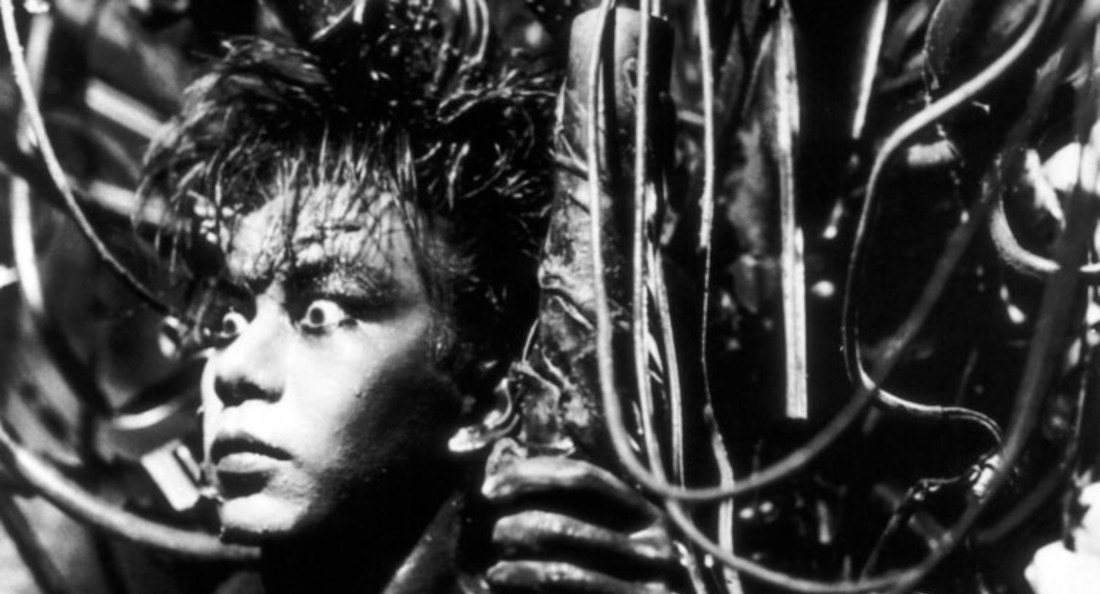Critipeg: Tetsuo: the Iron Man
★★★☆☆
TETSUOOOO! No, not the one from Akira, although the mutilation of young Japanese urbanites and telepathy do feature prominently in this film.
Tetsuo: The Iron Man (1989) is the latest Trash Cult Tuesday showing at the Dave Barber Cinematheque. The esteemed and affectionately named series serves cult-classic double features on a bloodstained platter for cinephiles and amateur thrill seekers alike.
The 67-minute film, presented in a disjointed and somewhat coherent narrative, occasionally flirts with the story of a young Japanese couple who are involved in a hit and run. After discreetly disposing of the jaywalker’s body (Shinya Tsukamoto), the so-called salaryman (Tomorowo Taguchi), begins sprouting increasingly larger scraps of metal all over his body, much to his girlfriend’s (Kei Fujiwara) bewilderment.
There has been much said about the “vaunted” Japanese work culture, and it’s hard to ignore the gleaming thematic coin at the bottom of the murky fountain. The whole film is shrouded in the shadow of industry, and not just because it’s in black and white. Just as David Lynch’s Eraserhead’s air of industrial languor was used to communicate the anxieties of fatherhood, Tetsuo is preoccupied with the neuroses of the working man.
The first five minutes of the film shows the aforementioned jaywalker living in squalor in an industrial park. As he brutally inserts metal in his own body, and the salaryman protagonist later contracts this like a sickness, director/writer/producer Shinya Tsukamoto conveys the mechanization of the workforce quite literally.
But the non-linear storytelling and themes are, again, mostly tangential. Limited by budget, Tsukamoto used stop-motion technology to great effect here. Combined with the frenetic pacing and smash cuts galore, he ensures an active viewing experience, even if it’s more unnerving than genuinely horrifying.
Special kudos to the prop and makeup crew for their work here. The gore may be the most authentic part of the picture. It takes a special touch to elevate the muddling of Spam and chocolate syrup into a crash course in anatomy.
Aside from that, the score can be heavy-handed and very typical of its decade. The direction is good but mostly trampled by the editing. The erotic aspects of the film, well ...
Perhaps the comedic scene in the film comes at some point smackdab in the middle, as the protagonist becomes more and more machine-like. As he and his love endeavour to get it on, he finds his member has been transformed into a three-foot-long industrial drill. How the rest of that plays out may be worth the $5 admission alone, but it does hit audiences with the grace of a Mack truck driven by Sigmund Freud.
So, where does it all coalesce? The back half of the film loses some of its gusto as it devolves into a stop-motion chase between the resurrected jaywalker and the salaryman. Their confrontations boil down to the hero stumbling around in what looks like a paper-mache Megatron costume, and it becomes harder to justify anything presented on screen as substance.
Ultimately, this is an intrepid, albeit proudly flawed cinematic experience. Tsukamoto is astute enough to stop his spiel before he overstays his welcome. It’s a lovely morass of wet, squishy bits and wacky, wide-eyed expressions, along with the always-comforting reminder that, yes, work is killing all of us.
Published in Volume 78, Number 05 of The Uniter (October 5, 2023)







